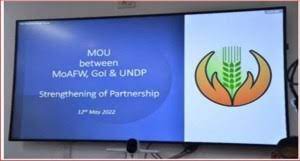16 May 2022 MoU between the Ministry of Agriculture and Farmers Welfare and the United Nations Development Program

MoU between the Ministry of Agriculture and Farmers Welfare and the United Nations Development Program – Today Current Affairs
- Recently the Ministry of Agriculture and Farmers Welfare (MoA&FW) and United Nations Development Program (UNDP) have signed a Memorandum of Understanding (MoU).
Today Current Affairs
Purpose of the MoU:
- UNDP will provide technical assistance for the Centre’s ambitious Pradhan Mantri Fasal Bima Yojana (PMFBY) and Kisan Credit Card scheme.
- Under the MoU, UNDP will use the expertise acquired from its global experiences in the system to support the Ministry of Agriculture for the implementation of joint agricultural credit and crop insurance.
PMFBY Scheme : The Hindu Analysis
- The scheme provides a comprehensive insurance cover to the farmers in the event of crop failure, which helps in stabilizing the income of the farmers.
- This scheme has been made mandatory for farmers taking loan in crop loan / Kisan Credit Card (KCC) account for notified crops, while other farmers can voluntarily join this scheme.
Scope : The Hindu Analysis
- All food and oilseed crops and annual commercial/horticultural crops for which past yield data is available.
Premium : The Hindu Analysis
- The fixed insurance premium / premium paid by the farmers under this scheme is 2% for all Kharif crops and 1.5% for all Rabi crops. Annual premium is 5% in case of commercial and horticultural crops.
- The premium cost of farmers’ share is shared equally by the states and the central government in the form of subsidy.
- However, 90% of the insurance premium subsidy under this scheme is borne by the central government in the states of Northeast India.
Coverage : The Hindu Analysis
- On an average more than 5.5 crore farmer applications are included in this scheme every year.
- Aadhaar Seeding (Linking of Aadhaar through Internet Banking Portal) has helped in expediting claim settlement directly in the accounts of farmers.
- During the locust attack in the Rabi 2019-20 season, a claim of about 30 crore rupees was presented in the state of Rajasthan, which is a remarkable example.
Pradhan Mantri Fasal Bima Yojana 2.0 : The Hindu Analysis
- Necessary reforms were made in PMFBY in the year 2020 Kharif season by the Central Government to ensure more efficient and effective implementation of the scheme.
- This modified PMFBY is also often called PMFBY 2.0, some of its features are as follows:
Totally Voluntary : The Hindu Analysis
- Under this, enrollment is 100% voluntary for all farmers from the Kharif crop of the year 2020.
Limited Central Subsidy : The Hindu Analysis
- The Union Cabinet has decided to limit the Central Government’s share on insurance premium rates to 30% for non-irrigated areas/crops and 25% for irrigated areas/crops under this scheme.
More autonomy to the states : The Hindu Analysis
- The Central Government ha s given wide relaxations to the States/UTs to implement PMFBY and also has given them the option to choose any additional risk cover/features in it.
Investing in ICE activities : The Hindu Analysis
- Now 0.5% of the total premium collected by insurance companies under this scheme will have to be spent on Information, Education and Communication (IEC) activities.
Use of Technology under PMFBY:
Crop Insurance App : The Hindu Analysis
- It provides easy enrollment facility to the farmers.
- Facilitates easy reporting of crop damages within 72 hours of occurrence of any incident.
Latest technical equipment : The Hindu Analysis
- Satellite imagery, remote-sensing technology, drones, artificial intelligence and machine learning are used to assess crop damage.
PMFBY Portal : The Hindu Analysis
- PMFBY portal has been launched for integration of land records.
Kisan Credit Card Scheme : The Hindu Analysis
- It was introduced in the year 1998 to provide adequate and timely cash credit through banking system to farmers with easy and simple procedures for their cultivation and other requirements such as purchase, withdrawal and production needs of agricultural inputs like seeds, fertilizers, pesticides etc. was introduced to provide assistance.
- This scheme was carried forward in the year 2004 to meet the investment credit requirement of farmers for allied and non-farm activities.
Objective:
Kisan Credit Card is provided with the following objectives : The Hndu Analysis
- Short term credit requirements for cultivation of crops.
- Post-harvest expenses.
- Agriculture-credit marketing for the consumption needs of the farmer family.
- Working capital for maintenance of agricultural assets and activities related to agriculture, such as dairy cattle, inland fisheries etc.
- Requirement of investment credit for agriculture and allied activities like pump sets, sprayers, dairy cattle etc.
Implementing agency : The Hindu Analysis
- Kisan Credit Card Scheme is implemented by commercial banks, regional rural banks, small finance banks and cooperative societies.
- Farmers are not given short term loan assistance for purchase of combine harvesters, tractors and mini trucks and for construction of house for the family and setting up of cold storage facility in the village.
Achievements : The Hindu Analysis
- As part of the self-reliant India package, the government has announced a credit incentive of Rs 2 lakh crore to 2.5 crore farmers under the Kisan Credit Card scheme.


No Comments